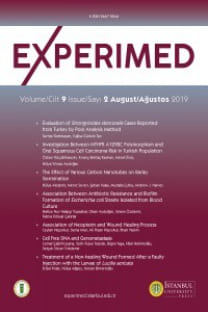Impact of Anogenital Distance Parameters on Female Sexual Dysfunction
Impact of Anogenital Distance Parameters on Female Sexual Dysfunction
Anogenital distance, genital hiatus, female sexual dysfunction FSFI, SQOL-F,
___
- 1. American College of Obstetricians and Gynecologists’ Committee on practice bulletins—Gynecology. Female sexual dysfunction: ACOG practice bulletin clinical management guidelines for obstetrician-gynecologists, number 213. Obstet Gynecol 2019; 134: 1-18. [CrossRef] google scholar
- 2. Carcedo RJ, Fernandez-Rouco N, Fernandez-Fuertes AA, Martinez-Âlvarez JL. Association between sexual satisfaction and depression and anxiety in adolescents and young adults. Int J Environ Res Public Health 2020; 17(3): 841. [CrossRef] google scholar
- 3. Imprialos KP, Koutsampasopoulos K, Katsimardou A, Bouloukou S, Theodoulidis I, Themistoklis M, et al. Female sexual dysfunction: A problem hidden in the shadows. Curr Pharm Des 2021; 27: 376274. [CrossRef] google scholar
- 4. Nappi RE, Tiranini L, Martini E, Bosoni D, Righi A, Cucinella L. Medical treatment of female sexual dysfunction. Urol Clin North Am 2022; 49: 299-307. [CrossRef] google scholar
- 5. Maldonado-Carceles AB, Sanchez-Rodriguez C, Vera-Porras EM, Ârense-Gonzalo JJ, Onate-Celdran J, Samper-Mateo P, et al. Anogenital distance, a biomarker of prenatal androgen exposure is associated with prostate cancer severity. Prostate 2017; 77(4): 406-11. [CrossRef] google scholar
- 6. Toprak T, Şahin A, Akgul K, Kutluhan MA, Ramazanoglu MA, Yilmaz M, et al. The relationship between anogenital distance and lifelong premature ejaculation. Andrology 2020; 8: 353-7. [CrossRef] google scholar
- 7. Sanchez-Ferrer ML, Prieto-Sanchez MT, Moya-Jimenez C, Mendiola J, Garcia-Hernandez CM, Carmona-Barnosi A, et al. Anogenital distance and perineal measurements of the pelvic organ prolapse (POP) quantification System. J Vis Exp 2018; 139: 57912. [CrossRef] google scholar
- 8. Ekmez M, Ekmez F. Effect of anogenital distance on stress urinary incontinence. African Journal of Urology 2021; 27: 1-5. [CrossRef] google scholar
- 9. Rosen R, Brown C, Heiman J, Leiblum S, Meston C, Shabsigh R, et al. The female sexual function index (FSFI): A multidimensional selfreport instrument for the assessment of female sexual function. J Sex Marital Ther 2000; 26: 191-208. [CrossRef] google scholar
- 10. Owiredu WKBA, Alidu H, Amidu N, Obirikorang C, Gyasi-Sarpong CK, Bawah AT, et al. Sexual dysfunction among diabetics and its impact on the SQoL of their partners. Int J Impot Res 2017; 29: 250-7. [CrossRef] google scholar
- 11. Rahman S. Female sexual dysfunction among muslim women: Increasing awareness to improve overall evaluation and treatment. Sex Med Rev 2018; 6: 535-47. [CrossRef] google scholar
- 12. Sertkaya Z, Ertaç K,Tokuç E. The relationship between premature ejaculation and anogenital distance. Andrologia 2020; 52: e13571. [CrossRef] google scholar
- 13. Domenici L, Palaia I, Giorgini M, Piscitelli VP, Tomao F, Marchetti C, et al. Sexual health and quality of life assessment among ovarian cancer patients during chemotherapy. Oncology 2016; 91: 20510. [CrossRef] google scholar
- 14. Abedi P, Jamali S, Tadayon M, Parhizkar S, Mogharab F. Effectiveness of selective vaginal tightening on sexual function among reproductive aged women in Iran with vaginal laxity: a quasi-experimental study. J Obstet Gynaecol Res 2014; 40: 52631. [CrossRef] google scholar
- 15. Millheiser LS, Pauls RN, Herbst SJ, Chen BH. Radiofrequency treatment of vaginal laxity after vaginal delivery: nonsurgical vaginal tightening. J Sex Med 2010; 7: 3088-95. [CrossRef] google scholar
- Yayın Aralığı: Yılda 3 Sayı
- Başlangıç: 2011
- Yayıncı: İstanbul Üniversitesi
Investigation of Galectin-3 Levels of Endometriosis Patients According to Stages
D. Fulya KIZILGEDİK, Armagan CANER, Çağlar YILDIZ, Buğra OKŞAŞOĞLU, Sema MISIR, İlhan YAYLIM, Semra DEMOKAN, Ceylan HEPOKUR
Esra AYDEMİR, Derya BURUKCU, Gürcan VURAL, Taner KIVILCIM, Fikrettin ŞAHİN
Gülşen GÜNEL, Levent AYDEMİR, Özlem ÜNALDI, Yasar NAKİPOĞLU
Mustafa Gani SÜRMEN, Tijen ALKAN BOZKAYA, Şanser ATEŞ, Saime SÜRMEN, Çağrı ÇAKICI, Sadrettin PENÇE, Neslin EMEKLİ
Ceren ÖZBEK, Revan Birke KOCA-ÜNSAL, Merva SOLUK TEKKEŞİN, Faruk ÇELİK, Hayriye Arzu ERGEN, Ümit ZEYBEK, Kıvanç BEKTAŞ KAYHAN, Meral ÜNÜR
An in silico Investigation of Anticancer Peptide Candidates in Fermented Food Microbiomes
A Bioinformatics Analysis of circRNA/miRNA/mRNA Interactions in Acute Myeloid Leukemia
Cihat ERDOĞAN, Murat KAYA, Ilknur SUER
Association of EGFR Gene Polymorphism with Glioma Susceptibility in Turkish Population
Gozde OZCAN, Fatma Tuba AKDENİZ, Seda GÜLEÇ, Zerrin BARUT, Deryanaz BİLLUR, Turgay İSBİR, Cumhur Kaan YALTIRIK
Delta Secretase and BDNF Signalling in Alzheimer’s Disease
Buse ÜNLÜ, Sümeyra ILDIZ, Duygun GEZEN AK, Erdinç DURSUN
Impact of Anogenital Distance Parameters on Female Sexual Dysfunction
